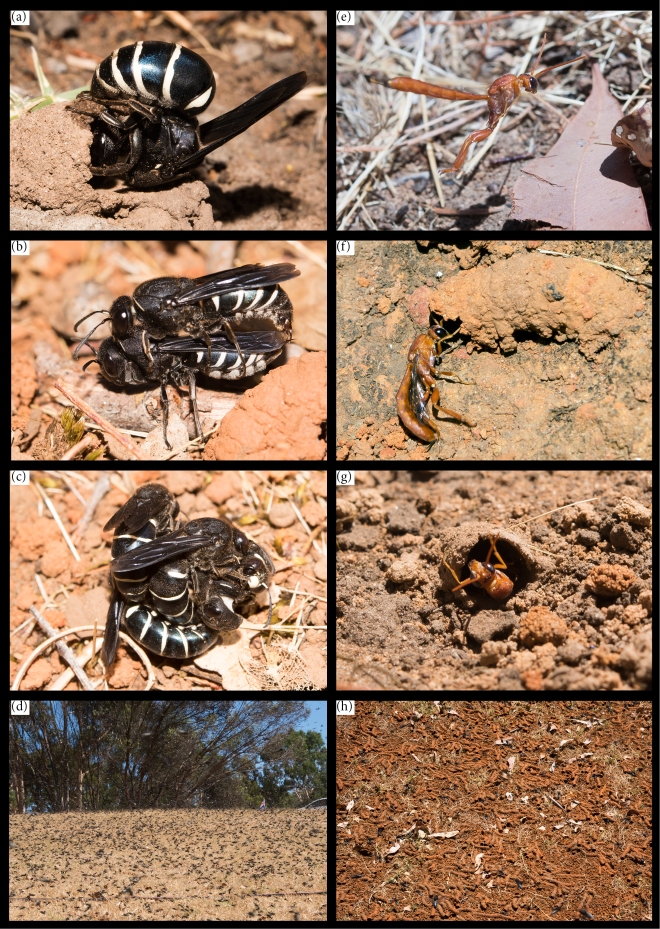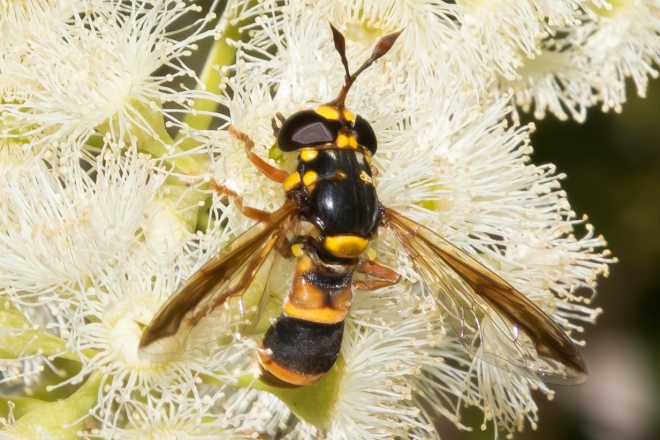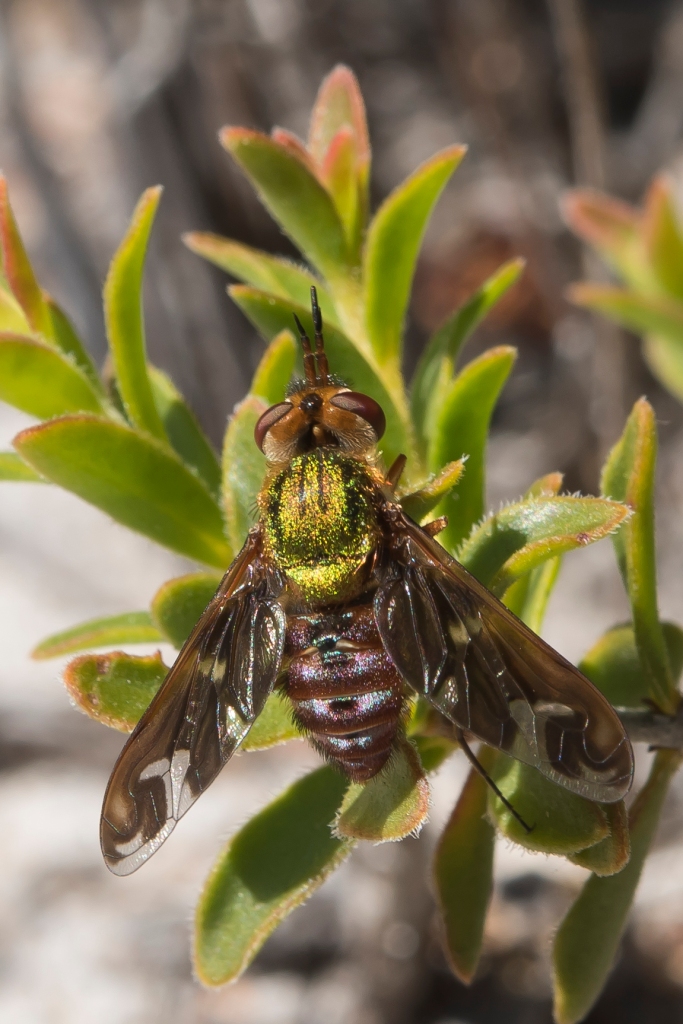January 2023: Hyleoides zonalis Smith, 1853 (Giant yellow banded masked bee)
These bees are mimics of potter wasps and are members of the Colletidae family (Plasterer bees) and in the subfamily Hylaeinae. They carry pollen in their crop (honey stomach). They have been recorded in Atlas of Living Australia from December to March, with the peak in December, mostly in the south west of Western Australia. These bees not only mimic the colouring of wasps, but also the darkening of the wings, and they hold their wings in a “V” shape when on plants. (Houston 1975)
This photograph was taken in Katanning by Dr Sue Jaggar.
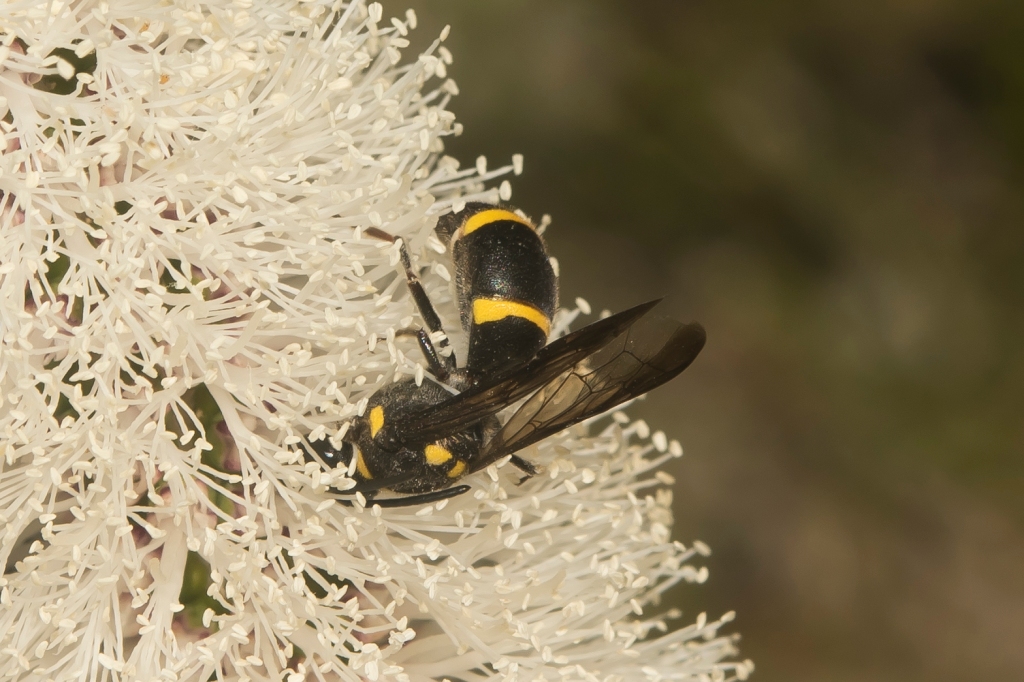
December 2022: Odontomyia sp Meigen, 1803 (Soldier fly)
I first found this brightly coloured fly in October on saltbush (Atriplex) that had been collected for cuttings, and the on Acacia In December I found it on Melaleuca huegeli and later on Eucaluptus utils. It is a soldier fly (Family: Stratiomyidae). This genus contains over 200 species, and have been reported on Atlas of Living Australia in all months, peaking in December, lowest in winter. The adults feed on nectar, and some species have been found feeding on dung. Larvae are aquatic, feeding on algae. Soldier fly are best known by the species Haermetia illucens, the black soldier fly, which is bred to provide protein for animals (eg chickens) and to clean up their dung. The frass of the soldier fly is used as a fertiliser.
This photograph was taken in Katanning by Dr Sue Jaggar.
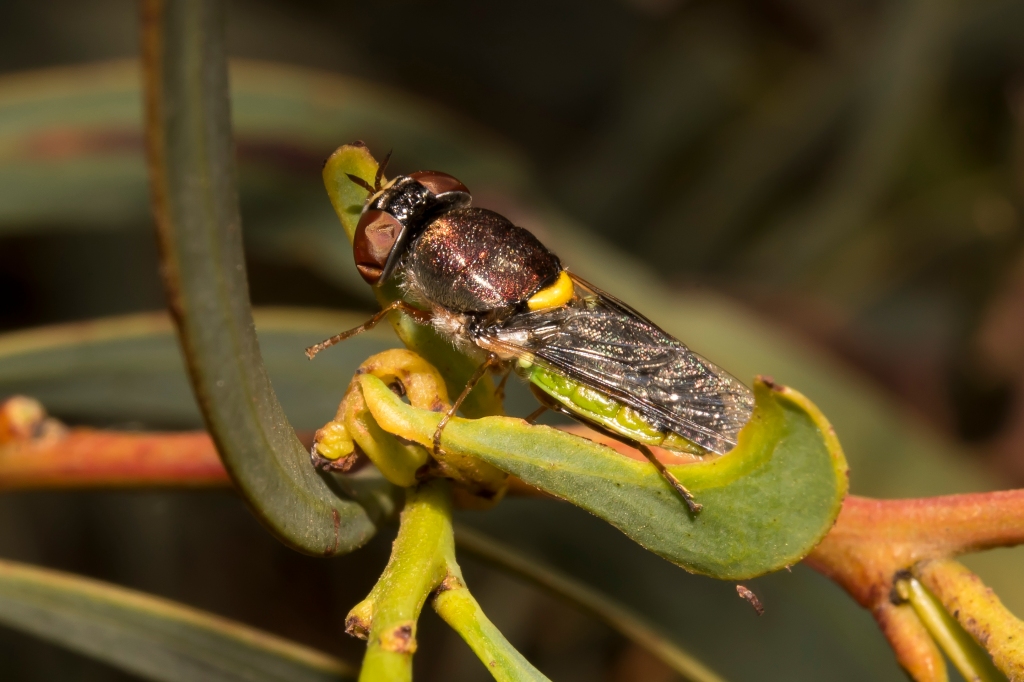
November 2022: Uraba lugens Walker, 1863 (Gum leaf skeletonizer)
The next stage in the lifecycle for Uraba lugens (the insect from October) is pupation. I like the way it has kept its heads outside the pupa.
This photograph was taken in Katanning by Dr Sue Jaggar.
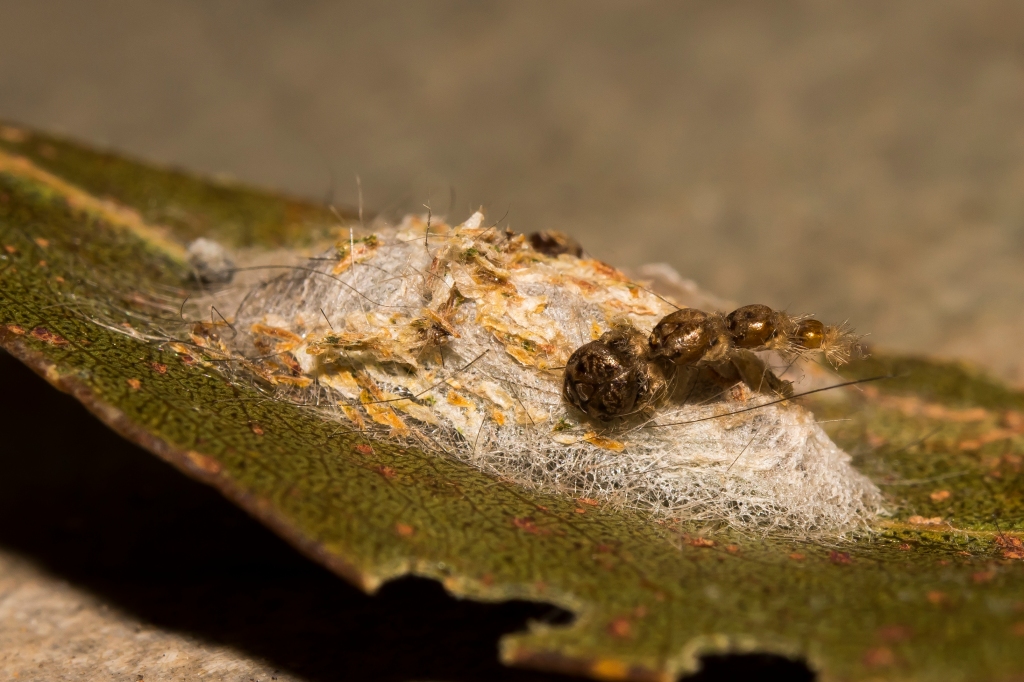
October 2022: Uraba lugens Walker, 1863 (Gum leaf skeletonizer)
These hairy caterpillars are juveniles of moths of the Nolidae family. There are hundreds on a couple of Eucalyptus trees where they have done a lot of damage to the leaves. When the caterpillar molts (sheds exoskeleton as it grows) it keeps the exoskeleton of it’s head, so some call it the “mad hatterpillar”.
I am currently rearing the caterpillar, so will provide a photo of the moth once it emerges.
This photograph was taken in Katanning by Dr Sue Jaggar.
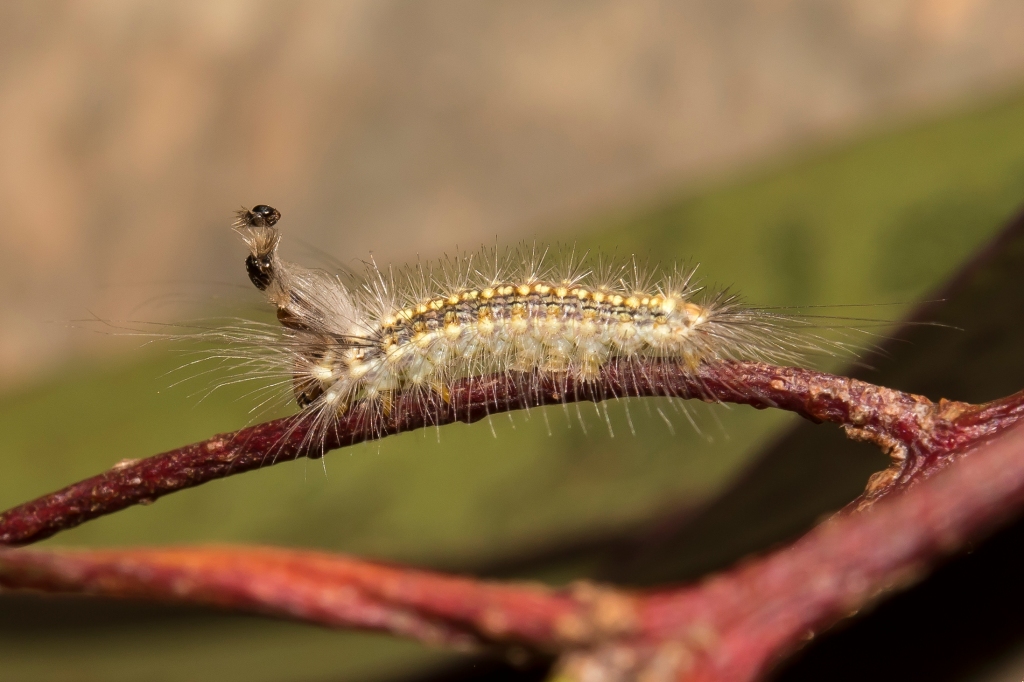
September 2022: Chrysopasta elegans Macquart, 1846 (Tachinidae)
Tachinid flies (Bristle flies) are a fascinating family they are fast fliers (Tachinos is greek for swift), with bristles on their abdomen. Adults are pollinators, and the fly in the photo has been dusted with pollen while foraging. Eggs are laid either into a habitat; or onto a food plant, they are ingested and hatch inside the host (such as a caterpillar); or laid onto a host insect (eg caterpillar, beetle grub or bee larva) using a glue or eggs modified with dart like spikes. The number of eggs laid is in proportion with the likelihood of finding a host, so those laid into the environment lay more eggs than those that lay directly onto a host. Some lay eggs that require incubation before the larvae emerge (oviparous), others emerge as soon as they are laid (ovolarviparous)
Chrysopasta elegans is in the subfamily Dexiinae, and the Rutiliini tribe. The Dexiinae have hosts that are generally beetle grubs or caterpillars. They lay hundreds to thousands of eggs into the habitat of the host. They larvae emerge as soon as the eggs are laid.
This photograph was taken in Woodanilling Nature reserve by Dr Sue Jaggar.
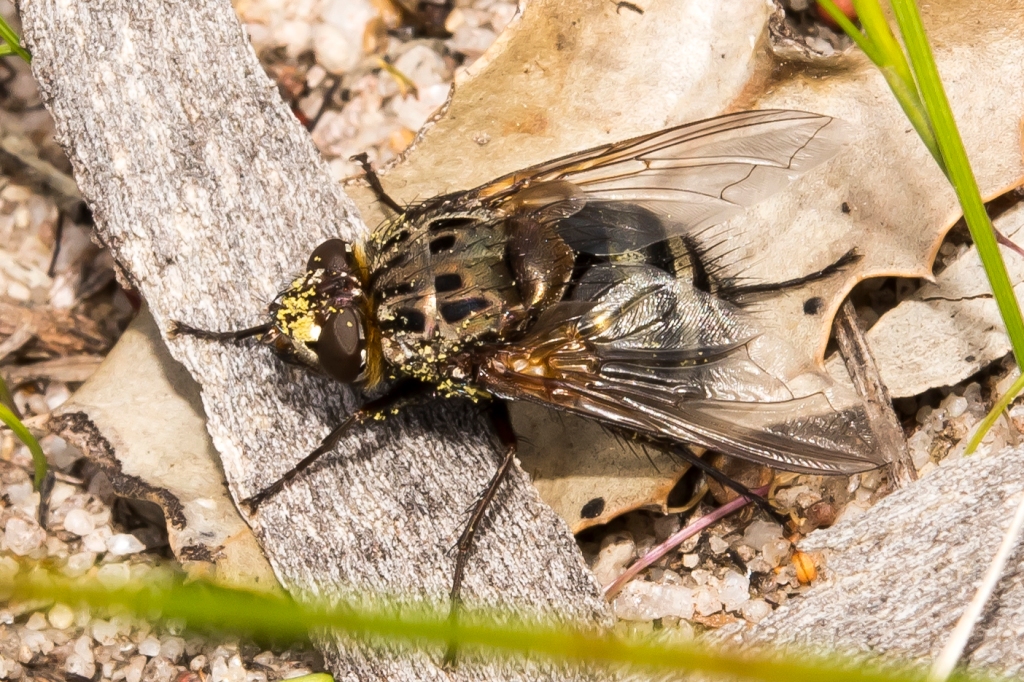
August 2022: Psyllidae (Jumping plant lice)
Psyllids live on plants and are sap suckers. Most are “host specific” which means each species of Psyllid feeds on only one species of plant. The young of some species of Psyllids cover themselves with a sticky covering, these are called lerps. This provides protection from their predators. There are many species that are yet to be described.
The photos below show :
Left: an adult Psyllid on a gall on Acacia sp she is carrying eggs, and may have a mite attached to her abdomen. She was around 1-2 mm long
Right and center: Lerps from the genus Glycapsis on Eucalyptus
These photograph was taken in Katanning by Dr Sue Jaggar.
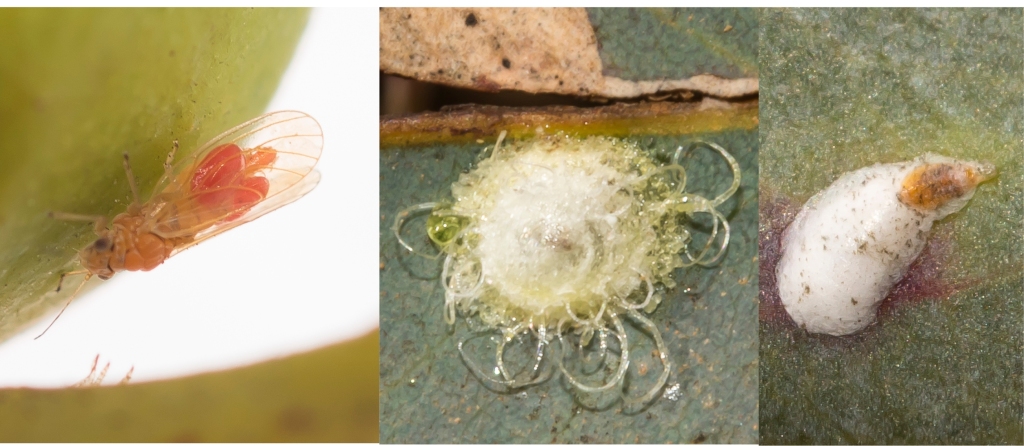
July 2022: Eurybrachidae Squathoppers
Squathoppers are Hemiptera (bugs) and they belong to the family Eurybrachidae, in the superfamily Fulgoroidea (Planthoppers). They are found on the trunks of Eucalyptus (gum) and Acacia (wattle) trees. The family name means “Broad and short” from ευρος (euros) and βραχυς (brachus). This is a nymph (juvenile), that was around 5mm long. They have good camouflage when on bark and feed on sap from the tree. The filaments on the abdomen are to mimic antennae, and when threatened they walk backwards while waving their antennae, so their abdomen is mistaken for their head. The Australian species are not regarded as pests. They do secrete honeydew (sweet, sticky excrement) so attract ants to the tree.
The NSW DPI have an online key for ID to Australian Genera: Key to Australian Eurybrachidae
This photograph was taken in Katanning by Dr Sue Jaggar.
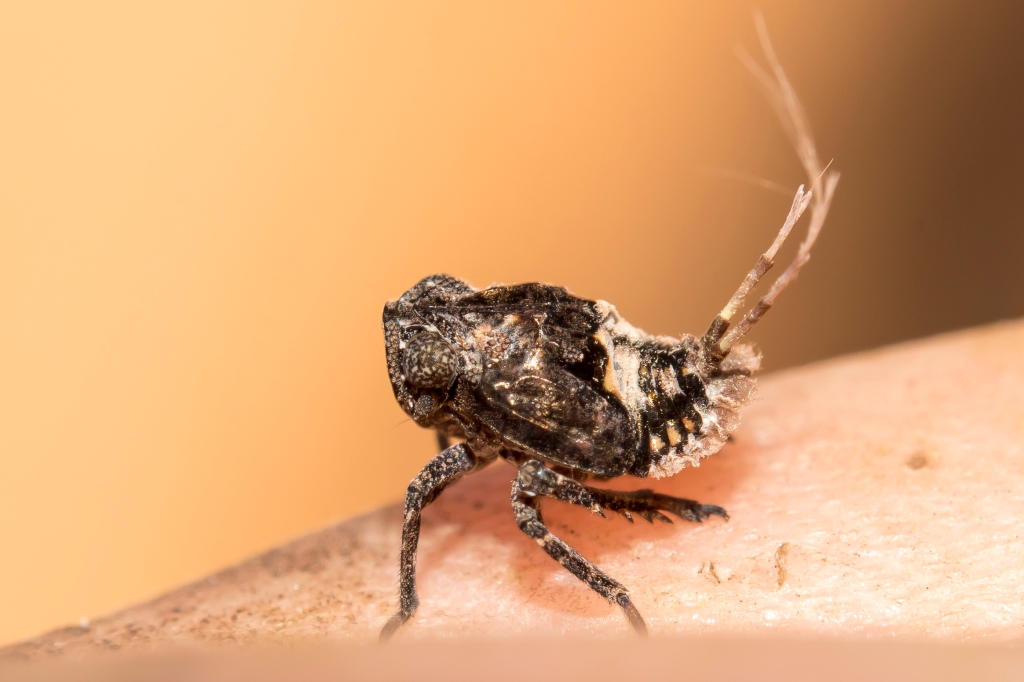
June 2022: Thyreus waroonensis (Cockerell, 1913) Waroona Cuckoo Bee
The Domino Cuckoo bee does not build it’s own nest or collect provisions. It lays it’s eggs in the nest of Amegilla sp (Blue banded bees), their larvae emerge before the Amegilla larvae, and eat the provisions of the host, this is known as kleptoparasitism. Males sleep in groups (aggregations) holding the perch (grass or stem) with their mandibles (mouths). They are members of the family Apidae, long tongued bees. When they pupate they spin cocoons (Houston 2018). The name comes from the greek “thyreos” (θυρεός) which refers to an oblong shield which is the shape of the scutellum (hard plate on thorax). This photograph was taken in Kings Park by Dr Sue Jaggar.
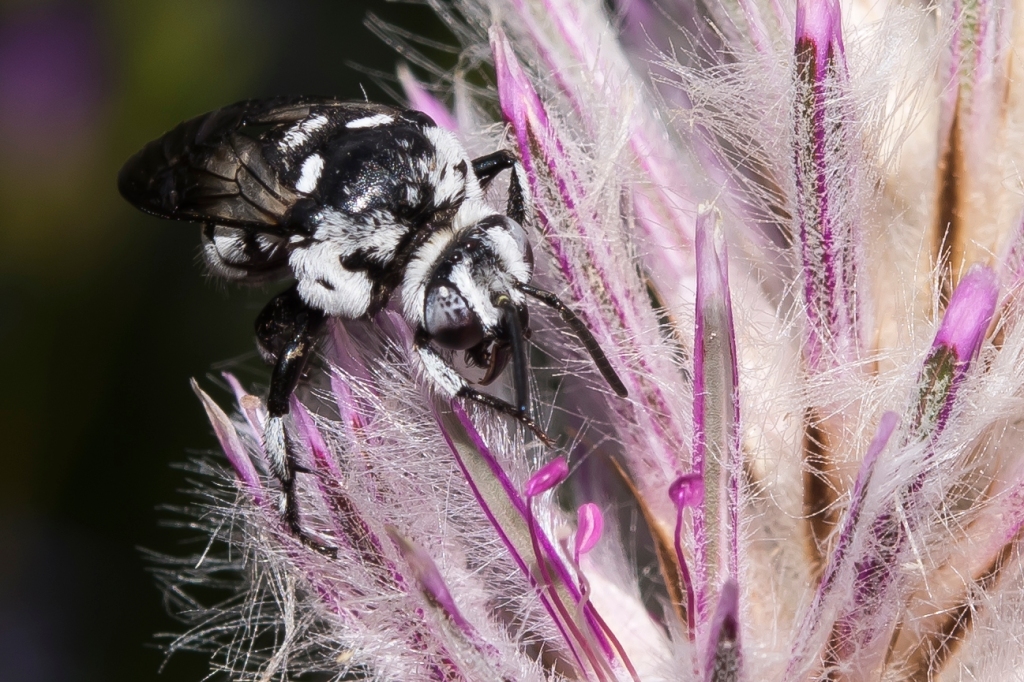
May 2022: Dasymutillini (Mutillidae), Velvet Ants
Dasymutillini are a tribe of velvet ants. The common name comes from their look, with the hairs resembling velvet and their form resembling ants, however they are actually wasps. The female (on the bottom) has no wings, while the male (on the top) is winged. Different species are either black or may also have bright orange/red and often have white or silver markings. Bright colours in insects are often signals of danger, in this case the danger is their sting. The sting can be very painful but is only used if they are threatened. Adults feed on nectar while eggs are laid into nests of ground nesting bees or wasps. The larvae attach themselves to the outside of the host (ectoparasitoid) which has been immobilised and does not develop, remaining as a larvae or pupae (idiobiont). This pair was photographed by Dr Sue Jaggar, at Nanson, WA. It is unusual to see the male active during the day.
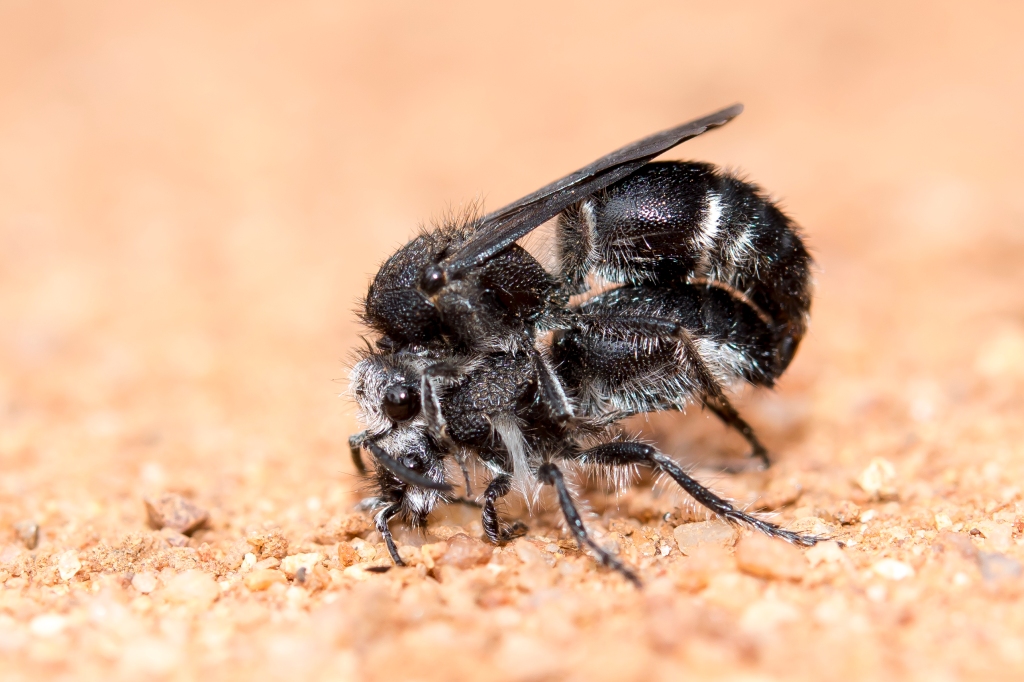
April 2022: Paragia tricolor (Masarinae) and Hyptiogaster sp (Gasteruptiidae)
There was a mass emergence of Paragia tricolor on a property in Bridgetown, WA, with most of the 2 acre property covered by nests. P. tricolor are pollen wasps that build nests in the ground with and collect pollen and nectar from Corymbia and pack it in the nest to provision their larvae (Houston 1986). The Hyptiogaster is a parasitoid that lays it’s eggs in the nest. Photographs by Dr Sue Jaggar.
(a) P tricolor building a tunnel entrance to the nest. They flew to the river and came back with water, which they used to make mud, and shaped the nest entrance which covered the vertical tunnels that formed the main part of the nest. These horizontal tunnel entrances were up to 10cm long. You can see the wet patch on the top of the tunnel which is being shaped by the wasp. The temperature was in the 30’s so the mud dried quickly.
(b) A mating pair of P tricolor.
(c) A mating swarm of P tricolor some of these mating groups had up to 100 wasps in them. The mating groups mainly occurred in the morning.
(d) The black cloud in front of the trees an over the ground is hundred of thousands of P. tricolor. Early in the morning they all seemed to be in flight, later in the day they were mostly on the ground.
(e) H. sp flying around searching for a potential nest
(f) H. sp checking a nest to see if it contains provisions.
(g) H. sp backing into the nest to oviposit
(h) Nests covering the ground, with P. tricolor busy making extensions.
March 2022: Ceriana sp (Syrphidae)
Ceriana sp on Melaleuca, observed in Kings Park, Perth by Dr Sue Jaggar. Ceriana are wasp mimicing hoverflies, the antennae are lengthened compared to most hoverflies, similar to wasps, they resemble Eumeninae (Potter wasps). There are 23 known species of Ceriana in Australia. The larvae of some members of the tribe Cerioidini are saproxylic (feeding on dead or decaying wood), some with association with tree sap. Adult females have been observed ovipositing onto the bark of trees. Ceriana ornatam is a species (common in Queensland) that is known to attack native sugar bag bee hives (a social group of native bees) and have adapted to honeybee hives. The larvae chew through the hive. It is thought they may have moved from Queensland to other states with the movement of bee hives.
February 2022: Stomorhina sp (Rhiniidae)
Stomorhina sp on daisy, observed in Stirling Gardens, Harvey by Dr Sue Jaggar. They were originally classified as Calliphoridae (blowflies) but have been reclassified so they belong to the Rhiniidae family, commonly known as pointy nosed flies. Stomorhina are often seen on flowers and have been recorded as good pollinators of Mango (Jaggar 2015). It is possible this is Stomorhina pollinosa. Little is known of the biology of this genus, although in Africa Stomorhina lunata are known to be egg predators on locust eggs (Greathead 2009) and the larvae of Stomorhina discolor (I have observed in good numbers on Mango in Queensland) have been found in ant nests and in roots where boring beetles are present (Moophayak et. al. 2017).
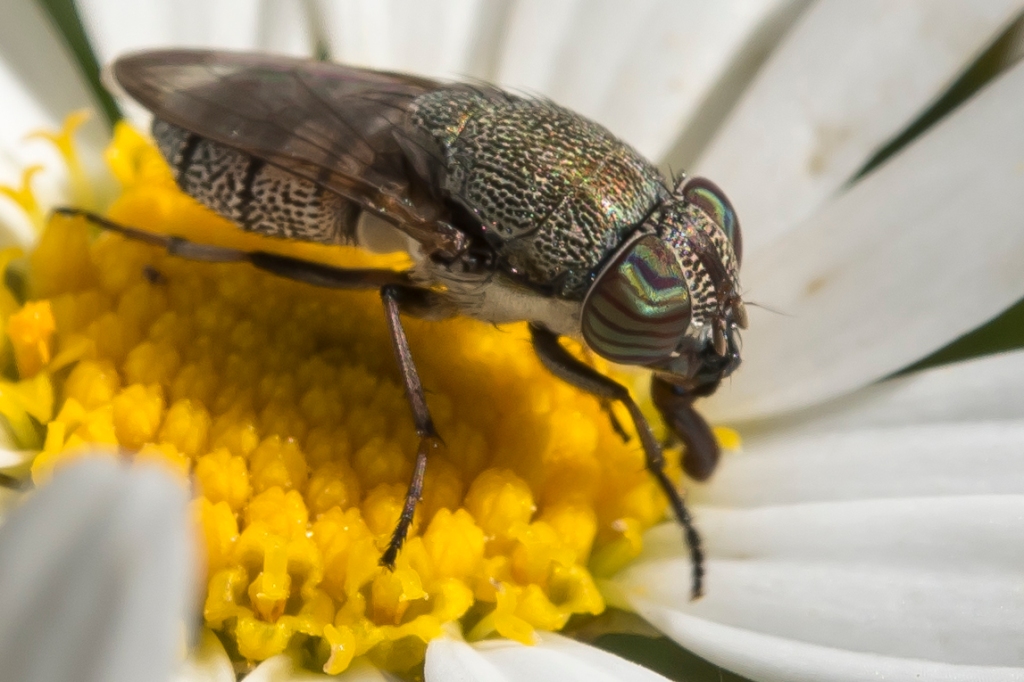
January 2022: Bembicinus sp
Bembicinus sp observed in Westralia Conservation Park (near Collie) by Dr Sue Jaggar. Bembicinae are sandwasps, they dig nests in the sand, lay eggs on a sand pedicel inside the nest and collect insects (like Hemiptera (true bugs) or grasshoppers) to pack in the nests with their eggs so that the young have food when they emerge. In this image the wasp is extending the nest. They are active between 25 and 45oC. They nest in aggregation. I saw 5 or 6 wasps active in the same area.
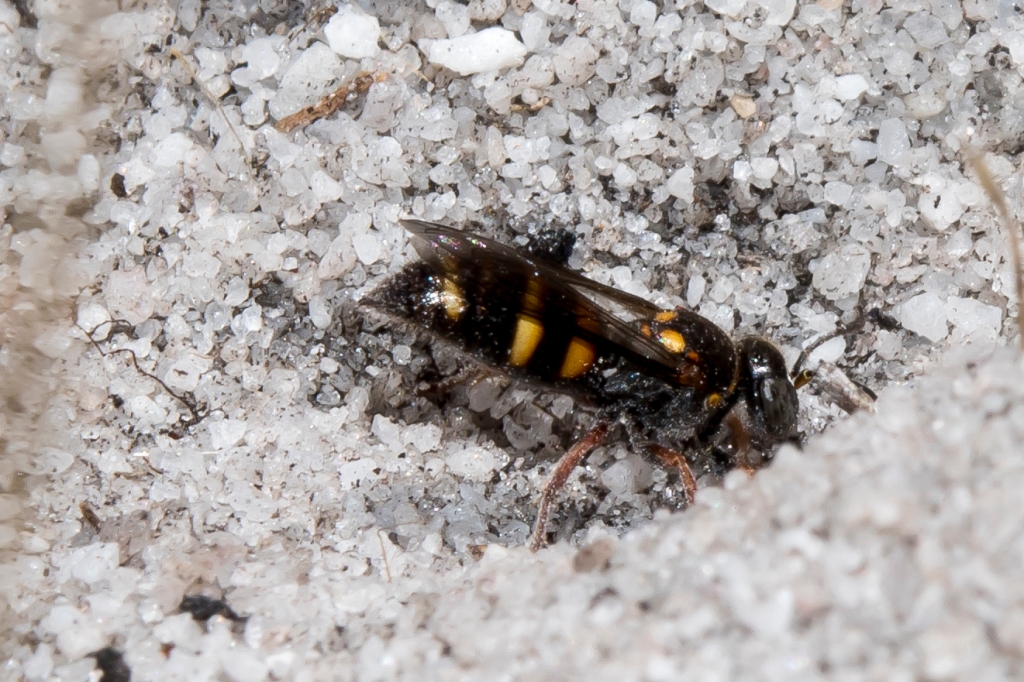
December 2021: Neosardus paramonovi
A Bombyliidae (beefly) observed in Lesueur National Park by Dr Sue Jaggar. Bombyliidae are pollinators as adults and parasitoids of other insects during their larval stage. More research is required to determine the hosts for larvae of many Bombyliidae species. Thanks to Dr Christine Lambkin for the ID to species level. In Yeates (1996) this species is only recorded in Perth (Ascot, Upper Swan, Gnangara, Wanneroo and Bullsbrook) and the only record in Atlas of Living Australia and iNaturalist is this one in Lesueur National Park. The green coloration on the thorax is only observed in live specimens.
References used:
Fletcher, M.J. (2000). Illustrated Key to the Genera of the family Eurybrachidae found in Australia (Hemiptera: Fulgoroidea) https://idtools.dpi.nsw.gov.au/keys/fulgor/eurybrachidae/eurygen00.htm
Greathead, D.J., (2009). The biology of Stomorhina lunata (Fabricus), predators of the eggs of Acrididae. Journal of Zoology 139(1): 139-180
Houston, T. F. (1975). A revision of the Australian Hylaeinae bees (Hymenoptera: Colletidae). Australian Journal of Zoology, supplementary series 36, p135.
Houston, T. F. (1986). Biological notes on the pollen wasp ‘Paragia (Cygnaea) vespiformis’ (Hymenoptera: Vespidae: Masarinae) with description of a nest. Australian Entomologist, The, 12(6), 115-118.
Houston, T.F. (2018). A guide to native bees of Australia. CSIRO Publishing.
Jaggar, S. (2015). Wild insects are efficient pollinators of Mango (Mangifera indica) in the Mareeba region, Qld. [Unpublished Masters Thesis] The University of New England.
Moophayak, K., Sanit, S., Chaiwong, T., Sukontason, K., Kurahashi, H., Sukontason, K. L., . . . Bunchu, N. (2017). Morphological Characteristics of Terminalia of the Wasp-Mimicking Fly, Stomorhina discolor (Fabricius). Insects, 8(1), 11.
Pearson, G., (31 December 2013). “The Mad Hatterpillar | WIRED”
Yeates, D.K. (1996). Revision of the Australian bee fly genus, Neosardus (Roberts). Invertebrate Taxonomy, 10(1), 47-75.

